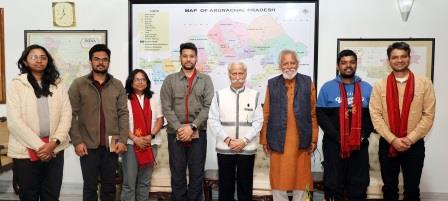-
 Governor lauds BRO on completion of strategically vital roads, bridges
Governor lauds BRO on completion of strategically vital roads, bridges
-
 Arunachalees exceptionally enterprising, forward-looking: Governor
Arunachalees exceptionally enterprising, forward-looking: Governor
-
 Arunachal Contingent to represent India at 7th Nordic Open Wushu…
Arunachal Contingent to represent India at 7th Nordic Open Wushu…
-
229 cases disposed in 4th National Lok Adalat
-
Lower Subansiri DA holds meeting for ‘Prashashan Gaon…
-
Dr Daying Ering remembered on 96th Birth Anniversary
-
IFCSAP condemns West Siang incident, says attempt to provoke unrest
-
Pakistan-backed spy arrested in Aalo just days after two…
-
Tragedy strikes workers en route to remote Chaglagam, 17 dead
-
Youth body calls for removal of illegal immigrants from ICR
By 2020, Mission Indradhanush aims to immunize at least 90 per cent of the children and women who have so far remained unvaccinated or did not receive the full recommended doses. It focuses on 201 high-priority districts and marginalized population groups where immunization coverage is low, exclusion and dropout rates for routine immunization are high, and the risk for disease outbreaks, including polio, is only too real.
Of the nearly six million children under the age of five who die from preventable causes every year around the world, 21 per cent are from India. Many of these children die because of malnutrition and infectious diseases. To truly reach the children most likely to die before their fifth birthday, we have to focus on the most vulnerable — children who are poor, live in rural areas.
Another big challenge for the government and healthcare providers is to seek solutions to barriers that prevent children from receiving vaccinations. These barriers include gender disparities, procurement and delivery challenges, too few frontline health workers and lack of information or misinformation on the benefits of immunization. In remote pockets of Arunachal, healthcare personnel are often threatened of dire consequences by parents and wards during routine immunization process. There is an innate fear among rural, uneducated folks regarding the side effects of immunization which is generally mild fever which is absolutely normal. Therefore, it is imperative that awareness is created.
This is not to say, that the country has not gone through a massive transformation when it comes to Universal Immunization.
India has made remarkable progress in achieving the Millennium Development Goals health-related targets. The country has been able to substantially reduce its under-five mortality rate from 126 deaths per 1,000 live births in 1990 to 53 deaths per 1,000 live births in 2013. But there is still a long way to go.
Extending immunization coverag

Kenter Joya Riba
(Managing Editor)She is a graduate in Science with post graduation in Sociology from University of Pune. She has been in the media industry for nearly a decade. Before turning to print business, she has been associated with radio and television.
Email: kenterjoyaz@easternsentinel.in / editoreasternsentinel@gmail.com
Phone: 0360-2212313

